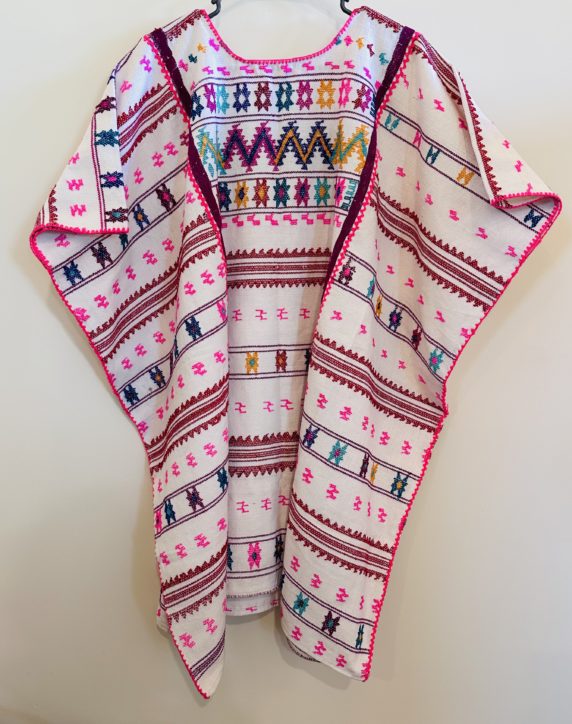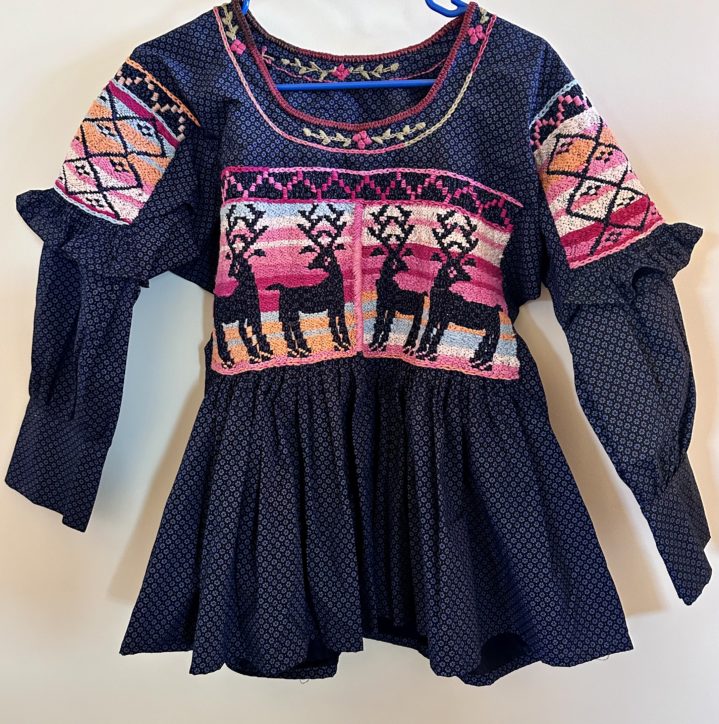Ghee, clarified buffalo or cow butter, is the essential cooking and flavoring oil in India. Ghee also has religious significance and is used at life cycle celebrations throughout the country. It is highly nutritious and is part of the ayurvedic system, which forms the basis of spirituality, food, and health.
One could say that ghee is the foundation of Indian life and culture, just as the tortilla is elemental to Mexico. I would venture to say that Aditi Prakash carefully chose the brand name Pure Ghee for the textile design company she started seven years ago to connect what she makes to what is second nature here. Elemental. Essential. Necessary.
Aditi employs women who are migrants, takes them off the street, trains them in sewing skills and gives them employment. Women sew. Men complete the finish work, led by a master tailor from the neighborhood, who supervises the apprentices. There are two levels of quality control and each product is nearly perfect, just like ghee.
Aditi invited Nidhi and me to her home for a simple Indian vegetarian lunch, to see her workshop studio, so I could learn about the processes and products, and meet the staff who make the bags and accessories that make their way to shops and boutiques throughout the country.
First, let’s talk about lunch.
Aditi says she uses turmeric in everything. Nidhi echoes this. Turmeric has antiseptic healing powers they say. They add it to yellow lentils with salt and cook the lentils in a stove top pressure cooker for about 30 minutes.
In a separate spoon with very large bowl, Aditi combines about 1/4 c. ghee, fresh curry leaves, red chilis from her home state of Hyderabad, cumin and mustard seed. The bowl of the spoon goes over the gas burner until the mixture simmers and cooks, coming to a low boil.
This is added to the lentils, that now has the consistency of a thick soup.
In another cooking pot is potatoes, cauliflower and peas.
Food is ayurvedic, Aditi says. Nidhi adds that cooking is not written down but passed through the generations as part of the cultural tradition. She learned from her mother. Both are independent, creative women who prepare vegetarian meals in the Hindu tradition daily for their husbands.
Homemade roti, a whole grain flat bread that looks like a tortilla (they both make this from scratch), and brown rice are served as a base for the lentils and vegetable medley. Everyone uses shallow metal plates that look like a cake pan.
We eat with the fingers of our right hand, important to bring the five elements from table to body, in complete circle of life and sustenance.
Aditi’s husband is a filmmaker. Both work from home and they built a three-level workspace where each has dominion. Aditi supports craft artisans from throughout India and as an industrial designer, has helped many refine their products to bring to the marketplace.
After lunch and a modest shopping spree (thank goodness Pure Ghee accepts credit cards), the three of us went off to the Nature Bazaar, a cooperative of crafts-people and textile artists from throughout the country.
Aditi says this has one of the best selections in all of Delhi, with very fair prices. It is off-the-beaten-path for tourists but well worth the visit. For me, it will need several hours. There are textiles, lengths of cloth by the meter, paintings and drawings, folk art, brass bells, sari, indigo and Khadi clothing, jewelry from Afghanistan.
If you haven’t noticed, India is about color, texture and sound. It is about silk, cotton and the resurgence of tradition. Both Nidhi and Aditi say that the sari is standard daily dress for women.
I’m going back to Nature Bazaar today. There are over 100 vendors with central payment stations. And, yes, credit cards accepted. Perfect for the cash crisis in play now. I’ll be writing more about this. Perhaps tomorrow.











































India Journal: Top Artisans at Nature Bazaar
Nature Bazaar is an effort by the Delhi Department of Tourism to bring the best artisans from throughout India to the city for permanent exhibition. Or, let me say, the space is permanent and the artisans rotate. So, it’s more of a pop-up and the artisans change about every six weeks. This group goes until November 30, 2016.
Indigo-dyed organic cotton block print from Rajasthan
I returned on my own so I could leisurely browse the textile collection, speak with the makers, and go through the stacks of cloth in search of indigo blue, red madder, turmeric root dyed yellow cloth. I didn’t want to miss anything. This extended to a three-hour meander to uncover as much as possible.
Block print yardage, turmeric w/ indigo over-dye (L). Madder w/indigo over-dye (R).
My textile artists friends tell me that the Nature Bazaar cooperative is the best source for India arts in Delhi. Funds from the purchases go directly to the artisans who participate.
Waiting patiently for customers, Nature Bazaar
My friend Lee Schwartz, who just returned from a 10-day tour of Rajasthan, claims she saw nothing of the quality on the tour that she encountered at the National Crafts Museum in Delhi. After a visit there, today, I still rank Nature Bazaar as the top shopping spot in Delhi, with second place going to FabIndia.
Ahmedabad artisan folds shawls inset with mirrors embroidered to silk/wool blend.
As with Oaxaca, it’s important to know where to source. I’ve decided to focus this India visit on textiles and not on typical sightseeing and monuments (though tomorrow we leave for Agra and the Taj Mahal).
Fine miniature paintings with gold leaf, an art form
There is so much here that zeroing in on what is important to me helps conserve energy. It’s impossible to get to more than two or three places in a day because of the intense traffic, horn-honking and dust. It just wears you out!
Indigo dyed patchwork quilt, with dresses, blouses on table.
At Nature Bazaar, I met Margaret Zinyu, who has a degree from the National Institute of Design in Ahmedabad. She planned to go into fashion design but decided to return to her native Nagaland, in northeast India on the Myanmar border, to work with local weavers using cotton dyed with indigo. She is just starting her company Woven Threads and this bazaar was the premiere of her products.
Margaret Zinyu of Woven Threads, Nagaland, India
India is at the crossroads of the ancient Silk Road. The people here are a multicultural blend of Asians and Europeans, Hindus and Muslims. There is as much diversity here as I see in Mexico. The people from the Himalaya foothills, part of India, bring their kite flying traditions to the crafts of the country, for example. These are for sale at the Nature Bazaar, too.
Most of India’s indigo is cultivated in Tamil Nadu, in the south
Wood carved stamps used for block printing at Nature Bazaar
There are also several stalls with hand-wrought silver jewelry from the Himalayas and Afghanistan. Many of the designs looked North African, like those I had seen in Morocco and southern Spain.
Tribal jewelry maker from Himachal Pradesh in the Himalayan foothills of India.
Example of ornate silver earrings inlaid with garnets and embellished with pearls.
There is no cochineal here, of course. This is a humid country and the insect is only found in hot, dry climates like Mexico where the nopal cactus thrives. So madder, the red dye that is more the color of red earth than intense carminic red, is what is found here. However, indigo is king in India and the British capitalized on its export starting in the early 17th century. Today, it is only cultivated in Tamil Nadu in the south of the country.
India’s indigo from Tamil Nadu, in the south
Walking the streets and riding the Metro, I see women of all ages wearing saris and the shalwar kameez pantsuit with tunic top and harem-style pants dyed with indigo blue. Women’s clothing of India is beautiful, lightweight and easy to wear.
India’s sari, block print with gold and indigo
Mexican indigo is extracted from the native plant Indigofera suffruticosa, known as añil, found in the tropics of the Americas. Native indigo from India is Indigofera tinctoria, known as true indigo, and is found in Asia and Africa. The plant and leaf structures are different, but the process to produce the color is the same.
Handmade palm brooms
The most intense blue comes by dipping the cloth at least several times in the indigo dye bath.
Papier mache toys and mobiles at Nature Bazaar
My goal on this trip is to bring back examples of of cloth dyed with indigo, using a variety of weaving, tie-dye and printing techniques.
Like this:
14 Comments
Posted in Cultural Commentary, Textiles, Tapestries & Weaving
Tagged blue, cloth, crafts, India, indigo, Mexico, natural dye, natural dyes, Nature Bazaar, New Delhi, organic cotton, shopping, textiles, weaving